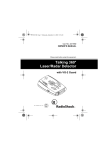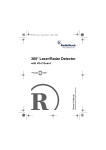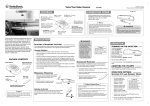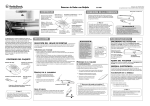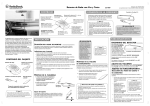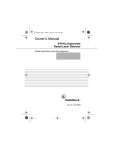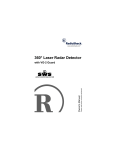Download Radio Shack 360 Owner`s manual
Transcript
Please read before using this equipment. Owner’s Manual Talking 360° Laser/Radar Detector with VG-2 Guard ˆ Contents Features ................................................................................. 4 A Quick Look ......................................................................... 7 Safety Warning System ................................................... 8 Installation ............................................................................. 9 Selecting a Mounting Location ........................................ 9 Mounting Guidelines ................................................. 9 Windshield Mounting ..................................................... 10 Hook-and-Loop Mounting ............................................... 11 Connecting Power .............................................................. 12 Operation ............................................................................. Turning On the Detector ................................................ Adjusting the Volume ..................................................... Tutorial Mode ................................................................. Starting the Tutorial Mode ...................................... Selecting the Demonstration for Each Alert ........... Finishing the Tutorial Mode .................................... Electronic Compass ....................................................... Calibrating the Electronic Compass ....................... When to Calibrate Your Detector ............................ Operation Settings ......................................................... Selecting the City and Highway Modes .................. Selecting Display Brightness .................................. Muting the Audio Alert ............................................ Selecting VG-2 Mode ............................................. 13 13 14 14 14 14 15 15 15 15 17 17 17 18 18 © 2002 RadioShack Corporation. All Rights Reserved. RadioShack and RadioShack.com are trademarks used by RadioShack Corporation. The compass technology used in this product is licensed under US patent numbers 4,851,777 and 5,239,264 from Precision Navigation, Inc. 2 Receiving and Identifying Radar, Laser, and Safety Alert Signals .................................................................................. 18 SWS Categories and Messages ............................ 19 Troubleshooting .................................................................. 24 Care and Maintenance ........................................................ 26 Replacing the Fuse ........................................................ 26 FCC Information .................................................................. 28 3 ˆ Features Your RadioShack Talking 360° Laser/Radar Detector can alert you to all known police traffic radar and laser systems with its distinct visual and audio alerts, including a voice alert. It receives X-, K-, and Ka-band radar signals, and detects both the instant-on and laser systems many police departments use to measure vehicle speed. Plus, your detector can give you advance warning of potential road hazards by detecting signals from transmitters that broadcast Safety Warning System alerts. Note: Before reading this Owner's Manual, read the supplied booklet Questions and Answers About Vehicle Speed Detection to familiarize yourself with the terms and uses associated with your detector. Your detector's features include: Electronic Compass — provides accurate heading information with alphanumeric display and LED panel. Voice Alert — greets you as you turn on the detector and alerts you with different vocal indicators including radar and laser detection. 360° Detection — detects laser signals from all around your vehicle. Alphanumeric Display — appears when you turn on the detector and alerts you with various text messages including radar and laser detection. 4 Features VG-2 Protection — makes your detector invisible to the VG-2 radar-detector when it senses VG-2 operation. X-, K-, Ka-Band, Laser, and Ultralyte Laser Signal Detection — warns you when it detects signals from traffic radar or laser devices. Different tones and display indicators let you know the type of signal received. Safety Warning System Detection — alerts you to the presence of potential road hazards, and emergency vehicles signaled by a Safety Warning System transmission. City/Highway Modes — let you minimize alerts when you are in areas that have false radar sources. City/Highway Selector and City/Highway Indicator — displays which mode is currently selected. FAST (False Alert Suppression Technology) — helps prevent false alarms caused by non-traffic radar sources. Tutorial Mode — lets you experience how the detector alerts you with its detection display and tones to the different signals the detector recognizes. Memory Retention — retains operational settings in memory without power, so when you turn on your detector, the setting will be the same as when you turned it off. Instant On or Pulse Radar Protection — alerts you to sudden high level and laser signals. Features 5 Your radar/laser detector includes the following items: • coiled power cord • windshield bracket with suction cups • hook and loop tape • stand for hook and loop mounting • spare fuse • Question and Answer About Vehicle Speed Detection Important: Some areas have laws regulating the use of radar detectors. Check with your local law enforcement agency about the laws in your area. 6 Features ˆ A Quick Look Speaker CITY 360° Laser Eye MUTE DIM Display VOLUME/OFF LED Compass 1. 360° Laser Eye — receives incoming laser signals directed at your vehicle from all directions 2. DC 12V Jack — the power cord connection 3. DIM — controls the brightness of the alphanumeric display 4. MUTE — silences the alert tone for about 20 seconds after the current signal is lost 5. CITY (City/Highway) — switches between the city and highway modes 6. Speaker — sounds a digital voice alert and tones let you know the types of radar and laser signals detected 7. LED Compass — indicates your heading information A Quick Look 7 8. VOLUME/OFF — lets you turn the detector on and off and adjust the volume 9. High Visibility Alphanumeric Display — provides a distinct visual of signal detected, signal strength, and heading information, and indicates the selected operating mode SAFETY WARNING SYSTEM The revolutionary Safety Warning System (SWS) has won formal approval from the Federal Communications Commission (FCC) to operate on the 24.05–24.25 GHz band for highway safety alerting and traffic signal control purposes. The Safety Warning System employs low-powered transmitters used by some emergency services and road crews to alert drivers to hazardous road conditions. The SWS can indicate many different emergency or hazardous conditions in the area (61 different messages are currently defined, with 3 additional messages for future use). The system has the potential to dramatically decrease the occurrence of traffic accidents by increasing a driver’s awareness of local road hazards. Having this safety alert compatible radar/ laser detector will ensure that you can benefit from this system wherever it is in use. 8 A Quick Look ˆ Installation SELECTING A MOUNTING LOCATION For the best performance, select a location for the detector where it has a direct view of the road. The detector's radar antenna is at the opposite end from display. Note: Though the detector has a 360° laser and radar detection coverage, the radar detection is more sensitive to the front. Mounting Guidelines Follow these guidelines when selecting a location. • Choose a location that does not block the driver's view of the road. • Mount the detector in a level position with a clear view to both the front and rear of your vehicle and insure its view of the road is not blocked by any metal object. • Some vehicles have InstaClear or ElectriClear defogging windshields, which have metal coatings that block signals. Some vehicles have a solar shield that block signals. Check your vehicle’s owner’s manual to see if your vehicle has these features. A detector installed in a vehicle with any of these features will probably not detect a signal. • Since window tinting reduces the received strength of laser signals, you should not mount the detector behind any tinted glass. Installation 9 • Do not mount the detector where the driver or a passenger might hit it in a sudden stop or accident. • Attach the stand to the bottom of the detector using the two tabs on the stand. Locate the tabs over the two openings on the detector’s base and press down. Note: After attaching the stand, to remove it, press on the tab until it clicks and remove the stand. Caution: When not in your vehicle, place your detector out of view to help discourage theft and to protect it from high temperatures. WINDSHIELD MOUNTING The supplied suction-cup windshield bracket lets you easily mount the detector on the windshield. Caution: Do not use the bracket in a vehicle that has a plastic coating on the windshield designed to protect passengers during an accident. If you use the bracket on this type of windshield, you might permanently mar the windshield's surface. For an alternative mounting method, see “Hook-and-Loop Mounting” on Page 11. 10 Installation 1. Clean the selected windshield area, position the bracket on the windshield, and press firmly on each suction cup to secure it in place. 2. Slide the detector onto the base plate until it snaps into place. To adjust the mounting angle, remove the detector from the bracket. Then, remove the bracket from the windshield and adjust it by carefully bending it. HOOK-AND-LOOP MOUNTING In some vehicles, the dashboard may be the best location to mount the detector. For this mounting, use the supplied hookand-loop tape as follows: 1. Use a damp cloth to clean the bottom of the stand and the dashboard. Let both surfaces dry. Note: The tape's adhesive might not stick to a surface treated with vinyl cleaner or protectant. Installation 11 2. Attach the stand to the bottom of the detector. Tape Stand Bottom of Detector 3. Remove the tape's paper backing and stick the tape to the bottom of stand. Remove the paper backing from the other side of the tape and press your detector onto the dashboard. ˆ Connecting Power Caution: • Use only the supplied power cord. If your power cord is lost or damaged, you can order a replacement cord from your local RadioShack store. • Before plugging the power cord's cigarette-lighter plug into your vehicle's cigarette-lighter socket, make sure the plug's tip is screwed firmly onto the plug. See “Replacing the Fuse” on Page 26 for more information about the cigarettelighter plug. 12 Connecting Power • Unplug the power cord's cigarette-lighter plug from your vehicle's cigarette-lighter socket when you turn off the ignition. This prevents your vehicle's battery from being drained if you leave the detector on when you turn off the ignition. Plug the supplied power cord's barrel plug into the detector's DC 12V jack. Then plug the cord's cigarette-lighter plug into your vehicle's cigarette-lighter socket. Note: If the detector does not operate when you turn it on, remove the cigarette-lighter plug from your vehicle's socket and check the socket for ashes and other debris. Also, check the fuse in the cigarette-lighter plug and your vehicle's fuse block (see “Replacing the Fuse” on Page 26). ˆ Operation TURNING ON THE DETECTOR To turn on the detector, rotate VOLUME/OFF toward VOLUME until it VOLUME/OFF clicks. The detector sounds a tone, and greets you with its voice alert — “Welcome! Buckle your seat belt,” VOLUME/OFF and a text message — WELCOME!. After self-testing, heading information and HWY appear. (See “Selecting the City and Highway Modes” on Page 17). To turn off the detector, rotate VOLUME/OFF toward OFF until it clicks and the alphanumeric display turns off. Operation 13 ADJUSTING THE VOLUME Rotate VOLUME/OFF to the left to increase the detector's volume. Rotate it to the right to decrease the volume. TUTORIAL MODE Your detector has a tutorial mode to demonstrate the alphanumeric display. Use the tutorial mode to familiarize yourself with the alphanumeric display. Starting the Tutorial Mode To start the tutorial mode, turn on the detector while holding down DIM and CITY. The tutorial mode starts when TUTORIAL and MODE flash alternately. Selecting the Demonstration for Each Alert To select the demonstration for each alert, press DIM. The detector displays each alert along with its corresponding audio alert. The detector demonstrates and displays the alerts in the following order: 1. X-Band Alert 7. Rock Slide Area Ahead 2. K-Band Alert 8. School Zone Ahead 3. Ka-Band Alert 9. Road Narrows Ahead 4. Laser Alert 10. Sharp Curve Ahead 5. Ultralyte Laser Alert 11. Pedestrian Crossing Ahead 6. VG-2 Alert 14 Operation Finishing the Tutorial Mode To end the tutorial mode, press MUTE at any time. ELECTRONIC COMPASS Your radar detector has an electronic compass that can display 8 different headings: N, E, S, W, NE, NW, SE, SW Note: The detector displays the electronic compass heading information until it picks up a signal. After the detector displays the signal, it returns to the electronic compass display. Calibrating the Electronic Compass You must calibrate the electronic compass in your area before using it. The calibration allows the electronic compass to separate the earth's magnetic field from the magnetic fields generated by external influences such as your vehicle so that the electronic compass provides accurate heading information. Before beginning the calibration, you must install the detector in your vehicle. See “Installation” on Page 9. The calibration is best performed on a leveled section of pavement, such as an empty parking lot. When to Calibrate Your Detector You must calibrate when: • It is being used for the first time. Operation 15 • It is being used in a different location. • The magnetic distortion flag, DISTORT is continuously displayed. Follow these steps to calibrate your detector. 1. Press CITY for more than 2 seconds until the voice says “Please turn your vehicle twice,” and CAL.... appears; then TURN and TWICE flash alternately. 2. With the detector mounted in your vehicle, turn the steering wheel all the way to the right or left and continue driving in a circular motion. Then press CITY. 3. After WAIT flashes 4 times, if the calibration is complete, SUCCESS! appears and the voice says “Calibration complete.” 4. If calibration is incomplete, the display scrolls PLEASE CALIBRATE AGAIN...PRESS CITY-KEY and the voice says “Please calibrate again.” After calibration, the heading appears. Note: To achieve calibration, two circles must be made and it must be performed on a level surface in less than 2 minutes. 16 Operation OPERATION SETTINGS Selecting the City and Highway Modes Your detector has two operating modes: city and highway. In city mode, the detector requires a stronger X-, K-, or Ka-band signal before it sounds or displays an alert. Notes: • City mode helps prevent false alerts in tightly populated areas where radar signals can bounce off surrounding structures. • The city mode has no effect on laser alerts or instant-on radar. The highway mode provides maximum sensitivity for open-road driving. The detector is preset to highway mode and HWY appears on the display when you turn it on. To select the city mode, press CITY. The voice says “City mode,” and CTY appears on the display. To return to the highway mode, press CITY again. The voice alert says “Highway mode,” and HWY appears on the display again. Selecting Display Brightness You can select from three levels of brightness for your radar detector: bright, dim, and dark. Once you set the display brightness, the detector retains the setting until you change it. Operation 17 Pressing DIM once reduces the display's brightness by half; the voice alert says “Display dim.” Pressing DIM a second time reduces the display's brightness by 90%; the voice alert says “Display dark.” Pressing DIM a third time returns the display to full brightness; the voice alert says “Display bright.” Muting the Audio Alert While the detector sounds a radar or safety alert signal, press MUTE to temporarily silence the detector. When you press MUTE, the voice alert says “Mute on” and M appears. The detector automatically resets the mute to off 20 seconds after the radar or safety alert signal stops. Or, press MUTE again before it resets, and the voice alert says “Mute off” and M disappears. Note: The laser alert signal remains audible even if you press MUTE. Selecting VG-2 Mode VG-2 mode is preset to off. To turn on VG-2, hold down MUTE until the voice alert says “VG-2 on” and VG2-ON appears. To turn VG-2 off, hold down MUTE until the voice alert says “VG-2 off” and VG2-OFF appears. RECEIVING AND IDENTIFYING RADAR, LASER, AND SAFETY ALERT SIGNALS When your detector senses a radar signal, X, K, or KA appears. An alert tone for the type of band detected sounds, and the display shows the signal strength in numeric form. 18 Operation Note: The closer you get to the source of the radar, the higher the signal strength number. When your detector senses an instant-on radar signal, INSTANT - ON appears and the instant-on alert tone sounds. For radar signal detection, if the signal strength number goes higher than 3, the voice alert says “X-band detected,” “K-band detected,” or “KA-band detected.” When your detector senses a laser signal, LASER flashes and the voice alert says “Laser detected.” When your detector senses an Ultralyte laser signal, ULTRALYTE LASER scrolls and the detector says “Ultralyte laser detected.” When VG-2 is detected, VG-2 appears and the voice alert says “VG-2 detected.” When your detector senses a SWS signal, a message appears depending on which SWS signal is detected, an alert tone sounds for the type of signal detected, and the voice alert announces the message. SWS Categories and Messages Category 1: Highway Construction Maintenance WORK ZONE AHEAD ROAD CLOSED AHEAD/FOLLOW DETOUR Operation 19 Category 1: Highway Construction Maintenance BRIDGE CLOSED AHEAD/FOLLOW DETOUR HIGHWAY WORK CREW AHEAD UTILITY WORK CREW AHEAD ALL TRAFFIC FOLLOW DETOUR AHEAD ALL TRUCKS FOLLOW DETOUR AHEAD ALL TRAFFIC EXIT AHEAD RIGHT LANE CLOSED AHEAD CENTER LANE CLOSED AHEAD LEFT LANE CLOSED AHEAD Category 2: Highway Hazard Zone Advisory I STATIONARY POLICE VEHICLE AHEAD TRAIN APPROACHING/AT CROSSING LOW OVERPASS AHEAD DRAW BRIDGE UP OBSERVE BRIDGE WEIGHT LIMIT ROCK SLIDE AHEAD SCHOOL ZONE AHEAD 20 Operation Category 2: Highway Hazard Zone Advisory I ROAD NARROWS AHEAD SHARP CURVE AHEAD PEDESTRIAN CROSSING AHEAD Category 3: Highway Hazard Zone Advisory II DEER/MOOSE CROSSING BLIND/DEAF CHILD AHEAD STEEP GRADE AHEAD/TRUCK USE LOW GEAR ACCIDENT AHEAD POOR ROAD SURFACE AHEAD SCHOOL BUS LOADING/UNLOADING NO PASSING ZONE DANGEROUS INTERSECTION AHEAD STATIONARY EMERGENCY VEHICLE AHEAD Category 4: Weather Related Hazards HIGH WIND AHEAD SEVERE WEATHER AHEAD Operation 21 Category 4: Weather Related Hazards HEAVY FOG AHEAD HIGH WATER/FLOODING AHEAD ICE ON BRIDGE AHEAD ICE ON ROAD AHEAD BLOWING DUST AHEAD BLOWING SAND AHEAD BLOWING SNOW WHITE OUT AHEAD Category 5: Travel Information/Convenience I REST AREA AHEAD REST AREA WITH SERVICE AHEAD 24 HOUR FUEL SERVICE AHEAD INSPECTION STATION OPEN INSPECTION STATION CLOSED REDUCE SPEED AREA AHEAD SPEED LIMIT ENFORCED HAZARDOUS MATERIALS EXIT AHEAD CONGESTION AHEAD/EXPECT DELAY 22 Operation Category 5: Travel Information/Convenience I EXPECT 10 MINUTE DELAY Category 6: Travel Information/Convenience II EXPECT 20 MINUTE DELAY EXPECT 30 MINUTE DELAY EXPECT 1 HOUR DELAY TRAFFIC ALERT/TURN ON AM RADIO PAY TOLL AHEAD TRUCKS EXIT RIGHT TRUCKS EXIT LEFT Category 7: Fast/Slow Moving Vehicles EMERGENCY VEHICLE IN TRANSIT POLICE IN PURSUIT OVERSIZED VEHICLE IN TRANSIT SLOW MOVING VEHICLE Operation 23 ˆ Troubleshooting If you have problems operating your detector, the suggestions in this section might help. If you cannot solve the problem after trying these suggestions, take your detector to your local RadioShack store for assistance. Problem Suggestion The detector does not turn on. Be sure all power connections are secure. The cigarette-lighter socket might be dirty. Clean it with fine emery cloth to ensure a good, clean connection. Check the fuse in the power cord's cigarette lighter plug. See “Replacing the Fuse” on Page 26. Check the fuse that controls power to your vehicle's cigarette-lighter socket. See your vehicle's owner's manual. Caution: Do not place any metal object other than the cigarette lighter or cigarette-lighter plug in the cigarette-lighter socket. Doing so could blow a fuse in your vehicle or cause the metal object to become very hot. 24 Troubleshooting Problem Suggestion The detector gives a false alert when you use vehicle accessories such as power windows, motorized mirrors, brakes, and so on. Check the vehicle's electrical system for loose connections, including the main battery cable and alternator connections. The detector performs the self-test, but does not respond to radar signals when you see a police car. A police car might not be equipped with radar (see the supplied booklet, Questions and Answers About Vehicle Speed Detection). Install a filter capacitor (1000 µF, 35 volts, on the back of the cigarettelighter socket, across the power connections. Police might be using VASCAR-type speed detection (see the supplied booklet, Questions and Answers About Vehicle Speed Detection). The detector has poor laser detection range. Be sure the laser detection lens is not blocked. Be sure the detector is properly mounted. See “Selecting a Mounting Location” on Page 9. Use lens-cleaning solution to clean the laser detection lens. Troubleshooting 25 ˆ Care and Maintenance Your RadioShack Talking 360° Laser/Radar Detector is an example of superior design and craftsmanship. The following suggestions will help you care for your detector so you can enjoy it for years. • Keep the detector dry. If it gets wet, wipe it dry immediately. Liquids might contain minerals that can corrode the electronic circuits. • Keep the detector away from dust and dirt, which can cause premature wear of parts. • Handle the detector gently and carefully. Dropping it can damage circuit boards and cases and can cause the detector to work improperly. • Wipe the detector with a damp cloth occasionally to keep it looking new. Do not use harsh chemicals, cleaning solvents, or strong detergents to clean the detector. Modifying or tampering with the detector’s internal components can cause a malfunction and might invalidate its warranty. If your detector is not performing as it should, take it to your local RadioShack store for assistance. REPLACING THE FUSE If the detector stops operating, follow these steps to check the fuse in the power cord's cigarette-lighter plug and replace it with a 2-amp, 11/4 × 1/4, fast-acting fuse, if necessary. 26 Care and Maintenance Caution: Using a fuse that does not meet this requirement can damage your detector, the power cable, or the vehicle's electrical system. 1. Turn the knurled ring on the cigarette-lighter plug counterclockwise to unscrew it. Knurled Ring Caution: If you must use pliers to loosen the ring, be careful not to crush the ring or the metal tip inside the ring. 2. Remove the ring and tip from the power cord’s cigarettelighter plug, then remove the old fuse. Fuse Note: Take care not to lose the ring, tip, or the spring inside the plug. 3. Check the fuse. If it has blown, replace it. 4. Replace the metal tip inside the ring, making sure the spring is intact, then place the fuse inside the cigarettelighter plug and screw the ring back onto the plug. Make sure the tip is visible when you reassemble the cigarettelighter plug. Caution: Never use pliers or other tools to retighten the ring on the cigarette-lighter plug. Care and Maintenance 27 ˆ FCC Information This device complies with Part 15 of the FCC Rules. Operation is subject to the following two conditions: (1) this device may not cause harmful interference, and (2) this device must accept any interference received, including interference that may cause undesired operation. Changes or modifications not expressly approved by RadioShack may cause interference and void the user's authority to operate the equipment. Limited One-Year Warranty This product is warranted by RadioShack against manufacturing defects in material and workmanship under normal use for one (1) year from the date of purchase from RadioShack company-owned stores and authorized RadioShack franchisees and dealers. EXCEPT AS PROVIDED HEREIN, RadioShack MAKES NO EXPRESS WARRANTIES AND ANY IMPLIED WARRANTIES, INCLUDING THOSE OF MERCHANTABILITY AND FITNESS FOR A PARTICULAR PURPOSE, ARE LIMITED IN DURATION TO THE DURATION OF THE WRITTEN LIMITED WARRANTIES CONTAINED HEREIN. EXCEPT AS PROVIDED HEREIN, RadioShack SHALL HAVE NO LIABILITY OR RESPONSIBILITY TO CUSTOMER OR ANY OTHER PERSON OR ENTITY WITH RESPECT TO ANY LIABILITY, LOSS OR DAMAGE CAUSED DIRECTLY OR INDIRECTLY BY USE OR PERFORMANCE OF THE PRODUCT OR ARISING OUT OF ANY BREACH OF THIS WARRANTY, INCLUDING, BUT NOT LIMITED TO, ANY DAMAGES RESULTING FROM INCONVENIENCE, LOSS OF TIME, DATA, PROPERTY, REVENUE, OR PROFIT OR ANY INDIRECT, SPECIAL, INCIDENTAL, OR CONSEQUENTIAL DAMAGES, EVEN IF RadioShack HAS BEEN ADVISED OF THE POSSIBILITY OF SUCH DAMAGES. Some states do not allow limitations on how long an implied warranty lasts or the exclusion or limitation of incidental or consequential damages, so the above limitations or exclusions may not apply to you. In the event of a product defect during the warranty period, take the product and the RadioShack sales receipt as proof of purchase date to any RadioShack store. RadioShack will, at its option, unless otherwise provided by law: (a) correct the defect by product repair without charge for parts and labor; (b) replace the product with one of the same or similar design; or (c) refund the purchase price. All replaced parts and products, and products on which a refund is made, become the property of RadioShack. New or reconditioned parts and products may be used in the performance of warranty service. Repaired or replaced parts and products are warranted for the remainder of the original warranty period. You will be charged for repair or replacement of the product made after the expiration of the warranty period. This warranty does not cover: (a) damage or failure caused by or attributable to acts of God, abuse, accident, misuse, improper or abnormal usage, failure to follow instructions, improper installation or maintenance, alteration, lightning or other incidence of excess voltage or current; (b) any repairs other than those provided by a RadioShack Authorized Service Facility; (c) consumables such as fuses or batteries; (d) cosmetic damage; (e) transportation, shipping or insurance costs; or (f) costs of product removal, installation, set-up service adjustment or reinstallation. This warranty gives you specific legal rights, and you may also have other rights which vary from state to state. RadioShack Customer Relations, 200 Taylor Street, 6th Floor, Fort Worth, TX 76102 12/99 RadioShack Corporation Fort Worth, Texas 76102 22-1691 09A02 Printed in Korea




























